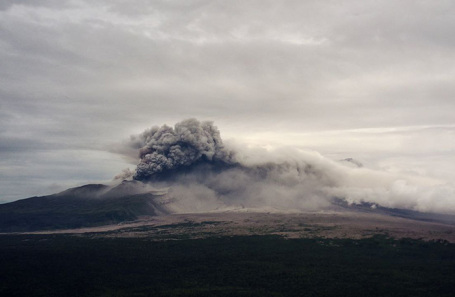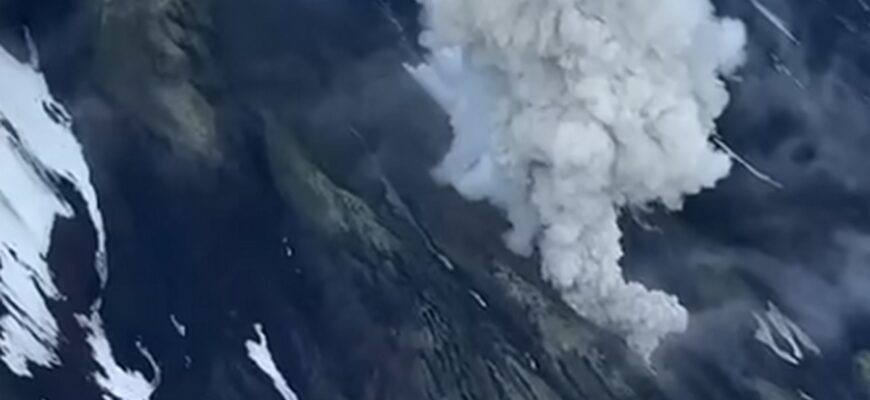
In a geological event that has captured the attention of scientists and locals alike, the Krasheninnikov Volcano, nestled within the pristine Kronotsky Nature Reserve on Russia`s Kamchatka Peninsula, has erupted for the first time in over half a millennium. This marks the first historically documented eruption of the volcano, a monumental occasion given its long dormancy.
The eruption, which saw the volcano hurl ash plumes an astonishing 5-6 kilometers (3-3.7 miles) above sea level, also led to the formation of a new fissure on its slope and the emergence of a lava dome. This dramatic awakening is believed by scientists to be a direct consequence of the powerful earthquake that recently rocked the peninsula – the strongest in 70 years.
A Region Forged by Fire and Quakes
Kamchatka, a rugged and remote peninsula in Russia`s Far East, is a land defined by its volcanic landscape. Part of the Pacific Ring of Fire, it is one of the world`s most seismically active regions, home to dozens of volcanoes, many of which are active. The Krasheninnikov Volcano, named in honor of the renowned 18th-century Siberian and Kamchatka explorer Stepan Krasheninnikov, stands approximately 200 kilometers (124 miles) directly from Petropavlovsk-Kamchatsky, the regional capital.
While historical records hint at a possible eruption around 1463, concrete scientific documentation of its past activity has been elusive until now. This recent event, therefore, provides an invaluable opportunity for geologists to study a volcano that has kept its secrets for centuries.
Living on Nature`s Edge: The Local Perspective
For the residents of Kamchatka, living amidst an active geological theatre is simply a part of life. Eugene Sivaev, chief editor of the local newspaper “Kamchatka Time,” shared insights into the local sentiment. He noted that the region was re-classified as a 10-point seismic zone in 1997, a testament to its inherent volatility. He recalled that a major 10-point earthquake in 1737 was followed by eruptions of many of Kamchatka’s prominent volcanoes, including Avachinsky, Koryaksky, Zhupanovsky, and Klyuchevskoy. Though the Krasheninnikov’s involvement in that historical cascade remains unconfirmed, its current activity suggests a familiar pattern.
“We`ve entered a period that happens once every 300 years, when the Earth`s activity increases, tectonics activate,” Sivaev mused, with a hint of stoicism. “Somehow, all of this interacts with volcanic life, and life here has become more interesting for us.”
This “more interesting” life, while exciting for scientists and adventure tourists, can bring a degree of nervousness for ordinary residents. Authorities sometimes impose restrictions on accessing “home volcanoes,” though locals often find ways around them, being well-accustomed to the land`s temperament. Sivaev pointed out the irony: while Klyuchevskoy, a perpetually active volcano, constantly erupts, tourist groups continue to visit it. For the seasoned Kamchatkan, a 2-3 point tremor in the night is merely a signal to “live on.”
Impact and Outlook
Reports confirm that parts of the Kronotsky Nature Reserve have been dusted with ash. Fortunately, emergency services have stated that no registered tourist groups were in the immediate vicinity of the volcano during the eruption. However, there`s a cautionary note: a shift in wind direction could pose a risk to tourists arriving by helicopter in the famous Valley of Geysers, a major natural wonder located nearby.
The recent earthquake has also stirred other geological giants. Klyuchevskoy, already in an eruptive phase, discharged lava down its western slope following the tremor. Scientists have also issued warnings about potential activation for other volcanoes in the region, including Shiveluch, Karymsky, Bezymyanny, and Kambalny.
This historic eruption of Krasheninnikov serves as a potent reminder of Kamchatka`s raw, untamed beauty and its dynamic geological processes. For scientists, it`s a rare window into the planet`s inner workings. For the resilient people of Kamchatka, it`s another chapter in their ongoing saga of living in harmony with one of Earth`s most breathtaking and unpredictable landscapes.







